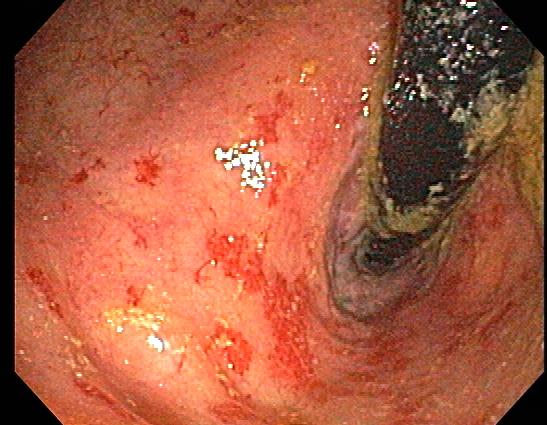[1]
Ballas LK,Elkin EB,Schrag D,Minsky BD,Bach PB, Radiation therapy facilities in the United States. International journal of radiation oncology, biology, physics. 2006 Nov 15;
[PubMed PMID: 17145535]
[2]
Otchy DP,Nelson H, Radiation injuries of the colon and rectum. The Surgical clinics of North America. 1993 Oct;
[PubMed PMID: 8378826]
[3]
Gilinsky NH,Burns DG,Barbezat GO,Levin W,Myers HS,Marks IN, The natural history of radiation-induced proctosigmoiditis: an analysis of 88 patients. The Quarterly journal of medicine. 1983 Winter;
[PubMed PMID: 6603628]
[4]
Palmer JA,Bush RS, Radiation injuries to the bowel associated with the treatment of carcinoma of the cervix. Surgery. 1976 Oct;
[PubMed PMID: 968730]
[5]
Hauer-Jensen M,Denham JW,Andreyev HJ, Radiation enteropathy--pathogenesis, treatment and prevention. Nature reviews. Gastroenterology & hepatology. 2014 Aug
[PubMed PMID: 24686268]
[6]
Villasanta U, Complications of radiotherapy for carcinoma of the uterine cervix. American journal of obstetrics and gynecology. 1972 Nov 15;
[PubMed PMID: 4633571]
[7]
Varma JS,Smith AN,Busuttil A, Correlation of clinical and manometric abnormalities of rectal function following chronic radiation injury. The British journal of surgery. 1985 Nov;
[PubMed PMID: 4063752]
[8]
Sharma B,Gupta M,Sharma R,Gupta A,Sharma N,Sharma M,Sharma V,Vats S,Gupta M,Seam RK, Four percent formalin application for the management of radiation proctitis in carcinoma cervix patients: An effective, safe, and economical practice. Journal of cancer research and therapeutics. 2019 Jan-Mar;
[PubMed PMID: 30880761]
[9]
Kapp KS,Stuecklschweiger GF,Kapp DS,Poschauko J,Pickel H,Hackl A, Carcinoma of the cervix: analysis of complications after primary external beam radiation and Ir-192 HDR brachytherapy. Radiotherapy and oncology : journal of the European Society for Therapeutic Radiology and Oncology. 1997 Feb;
[PubMed PMID: 9106923]
[10]
Ali F,Hu KY, Evaluation and Management of Chronic Radiation Proctitis. Diseases of the colon and rectum. 2020 Mar;
[PubMed PMID: 32032142]
[11]
Mendelson RM,Nolan DJ, The radiological features of chronic radiation enteritis. Clinical radiology. 1985 Mar;
[PubMed PMID: 4064491]
[13]
Dziki Ł,Kujawski R,Mik M,Berut M,Dziki A,Trzciński R, Formalin therapy for hemorrhagic radiation proctitis. Pharmacological reports : PR. 2015 Oct;
[PubMed PMID: 26398382]
[14]
al-Sabbagh R,Sinicrope FA,Sellin JH,Shen Y,Roubein L, Evaluation of short-chain fatty acid enemas: treatment of radiation proctitis. The American journal of gastroenterology. 1996 Sep;
[PubMed PMID: 8792704]
[15]
Paquette IM,Vogel JD,Abbas MA,Feingold DL,Steele SR, The American Society of Colon and Rectal Surgeons Clinical Practice Guidelines for the Treatment of Chronic Radiation Proctitis. Diseases of the colon and rectum. 2018 Oct;
[PubMed PMID: 30192320]
Level 1 (high-level) evidence
[16]
McElvanna K,Wilson A,Irwin T, Sucralfate paste enema: a new method of topical treatment for haemorrhagic radiation proctitis. Colorectal disease : the official journal of the Association of Coloproctology of Great Britain and Ireland. 2014 Apr;
[PubMed PMID: 24299100]
[17]
Oscarsson N,Arnell P,Lodding P,Ricksten SE,Seeman-Lodding H, Hyperbaric oxygen treatment in radiation-induced cystitis and proctitis: a prospective cohort study on patient-perceived quality of recovery. International journal of radiation oncology, biology, physics. 2013 Nov 15;
[PubMed PMID: 24035333]
Level 2 (mid-level) evidence
[18]
Hoggan BL,Cameron AL, Systematic review of hyperbaric oxygen therapy for the treatment of non-neurological soft tissue radiation-related injuries. Supportive care in cancer : official journal of the Multinational Association of Supportive Care in Cancer. 2014 Jun;
[PubMed PMID: 24794980]
Level 1 (high-level) evidence
[19]
Swan MP,Moore GT,Sievert W,Devonshire DA, Efficacy and safety of single-session argon plasma coagulation in the management of chronic radiation proctitis. Gastrointestinal endoscopy. 2010 Jul;
[PubMed PMID: 20493484]
[20]
Jao SW,Beart RW Jr,Gunderson LL, Surgical treatment of radiation injuries of the colon and rectum. American journal of surgery. 1986 Feb
[PubMed PMID: 3946764]
[21]
Pricolo VE,Shellito PC, Surgery for radiation injury to the large intestine. Variables influencing outcome. Diseases of the colon and rectum. 1994 Jul;
[PubMed PMID: 8026234]
[22]
Lev EL,Eller LS,Gejerman G,Lane P,Owen SV,White M,Nganga N, Quality of life of men treated with brachytherapies for prostate cancer. Health and quality of life outcomes. 2004 Jun 15;
[PubMed PMID: 15198803]
Level 2 (mid-level) evidence
[23]
Liauw SL,Sylvester JE,Morris CG,Blasko JC,Grimm PD, Second malignancies after prostate brachytherapy: incidence of bladder and colorectal cancers in patients with 15 years of potential follow-up. International journal of radiation oncology, biology, physics. 2006 Nov 1;
[PubMed PMID: 16887293]

